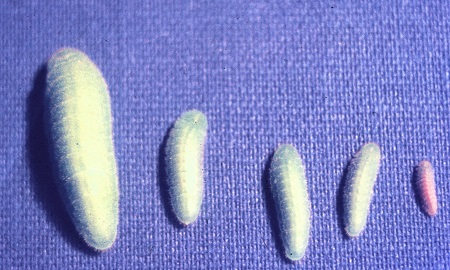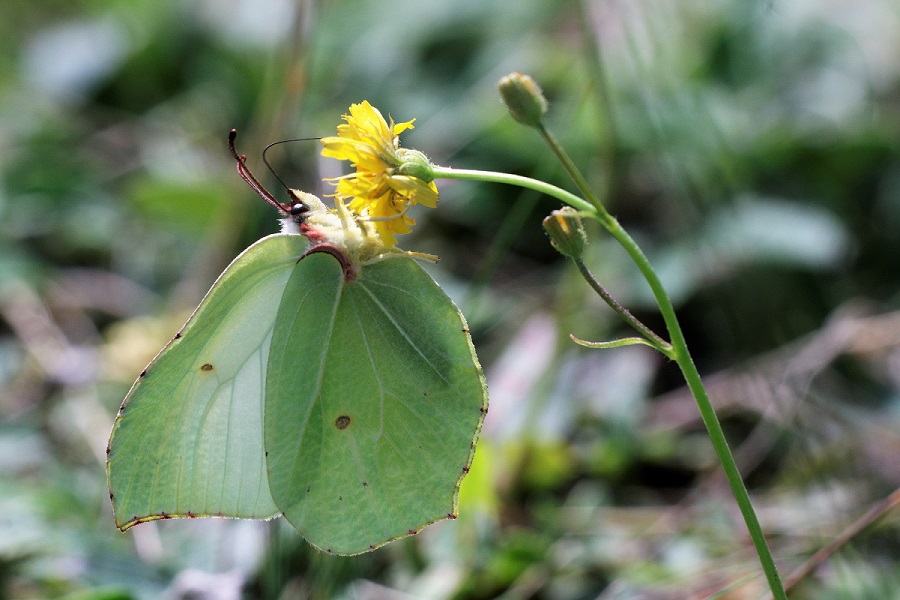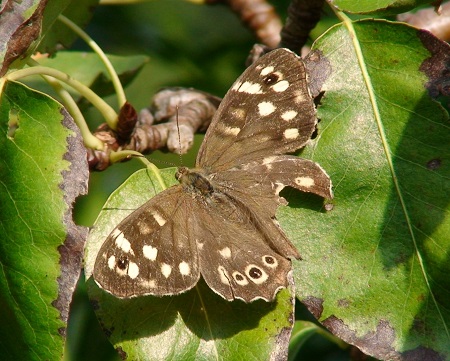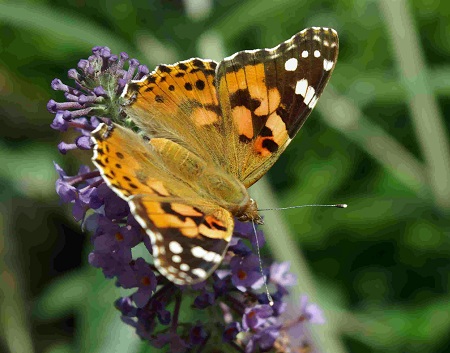|
8. Behaviour over time
Behaviour over time comes about by traits that control the lifecycle. Seven traits are considered here which mould behaviour over time.
The lifecycle of a species is mainly determined by the over wintering stage and the time required for both larval growth and reproduction of the adults. The required time for the last one may vary from a few days to a whole year.
The spread in the expression of these traits is very important and this phenomenon is considered as a trait in itself. The development of all individuals of a species can be synchronous; on the other hand there are species in which there is such a large difference in their development time that it looks as if there are several generations per year. This trait of spreading in various phases of the lifecycle is very important in the survival prospects of a population and has a hereditary base.
The occurrence of a species is limited in the northern or alpine range by the length of the growing season. A comparison of the local climate data and the total period required for the development of the species will clarify this. The suitable period of the year, the climate window, must fit with the required time to complete the development of the species (See chapter 14 Climate matrix). This figure can be obtained by adding up the times taken by all the stages of the life cycle.
1. Overwintering
Overwintering can take place in any stage, which one depends on the species. Every stage has its particular chance to survive the winter.
Adult butterfly
The adult has an opportunity to look for a safe place for hibernation. The adult can be seen very early in the year, on the first favourable day, looking for food and also very late in the year looking for a good shelter.
In the case of migrants the butterfly overwinters in southern regions with mild winters, in spring or early summer the old individual or its descendants return to the north.
|
|
Behaviour over time is based mainly on the sightings of the adults throughout the year. However to deduce the development from the cycle is risky.
The brimstone (Gonepteryx rhamni) is seen most of the year, though there is only one generation per year.
Photograph: Jeroen Voogd ©. |
Pupa
The pupa overwinters in a sheltered place or is so robustly constructed that it can survive very adverse weather conditions. The butterfly will appear early in the spring after a warm period for the butterfly to develop inside the pupa.
Fully grown larva
The larva has gathered already all the food it needs and in spring it is waiting for a warm period to pupate without further feeding, but sometimes it drinks raindrops. The butterfly will appear somewhat later in the season than species with overwintering pupae.
Half-grown larva
The half-grown larva has had already a feeding period in the previous summer or autumn and needs a second feeding period in spring. The new-born larvae feeds on old leaves, usually of low nutritious quality, in spring it continues on fresh leaves when the larva usually grows much faster. The butterflies are usually on the wing in mid-summer.
New-born larva
After the egg is laid in the summer or autumn the larva will hatch but it will not eat, except part of the egg-shell, till next spring. Then it starts to eat as soon as its food becomes available.
Egg
Usually an overwintering egg contains a fully developed young larva. The embryo has fully developed within two or three weeks after oviposition in the summer. Its body will shrink somewhat during the winter and in spring it swells by absorbing atmospheric moisture. This is a critical phase, the weather should be predictable with raising temperature and moisture. These species are typically high summer butterflies.
Several instars
A few species are able to hibernate in various stages, the famous example is the speckled wood (Pararge aegeria) of which individuals are able to pass the winter either as half-grown larva or pupa.
| |
|
|
The speckled wood (Pararge aegeria) is seen throughout the year as the brimstone.
However its life cycle is very complicated, it produces several generations per year. To deduce the number of broods (voltinism) from these sightings is risky.
Photograph: Frits Bink ©. |
| |
In the case of the painted lady (Vanessa cardui) the sightings will produce just a pattern of immigration waves, because the butterfly is not fit to overwinter in our climate.
Much of what happens over time will take place in the larval stage. Rearing experiments clarify a lot of the secrets.
Photograph: Frits Bink ©. |
|
|
|
|
2. Reproduction
Behaviour over time with regard to reproduction relates to the time required to complete this process. It is the time that the butterfly lives after hatching from the pupa. Two periods determine the course of this phase of the lifecycle: the period from hatching till the first egg is laid, the pre-oviposition time, and the period after that till egg production stops.
These periods are difficult to measure and information can only be obtained by collecting data from different sources. Most informative are the data obtained from breeding experiments. Another approach is the dissection of butterflies in successive stages of life. The collation of this kind of data will provide ideas of what happens in nature. The egg load of a single ovariole is taken here as the starting point. See chapter 4, about construction for details.
Table 8-1. Dissections and count of one ovariole (after size 0.05 only visible under microscope).
| nr |
name species |
Number of ova in each size category in single ovariole, where sizes are a proportion of a fully shelled ovum |
| date |
age |
present egg load |
estimated egg production |
observed egg production |
1.0 |
0.5 |
0.3 |
0.1 |
0.05 |
0.03 |
0.01 |
0.005 |
| d-m-year |
day |
real number |
sum up 1.0 to 0.05 |
noticed in experiment |
ready
to lay |
halve size |
- |
- |
just visible |
too small |
- |
cell only |
The small eggs can be counted using a stereo-microscope of 20 times magnification. The dissolution liquid to make these small eggs visible is a mixture of equal quantities of ethanol, glycerine and water.
There are butterflies which start oviposition straight after hatching and copulation and their abdomen is already empty within three days. They will hatch with all eggs fully developed and only a few small ones will be left in the ovariole, for example the alcon blue (Maculinea alcon). There are also butterflies which hatch with all eggs present but these are not fully developed. The butterfly needs about five to seven days before the eggs have ripened. In such cases the butterfly needs no food for egg development, only warmth, for example the marsh fritillary (Euphydryas aurinia). This butterfly lays its eggs at once in one big batch of about 300 eggs, sometimes up to 600, this way of oviposition is called semelparity. On the other hand there are butterflies which hatch without eggs and start egg laying after a considerable amount of time, this can be nearly a year.
The usual way is that a freshly hatched butterfly has a small amount of unripe eggs and a large amount of tiny eggs in all sizes down to nearly invisible ones. After a week or so it starts to oviposit and it will continue laying for a couple of weeks. The small eggs need time and nutrition to ripen before they are laid. This way of oviposition behaviour is called iteroparity.
There are extreme examples in the case of nomadic, migratory or overwintering species. These are the butterflies which hatch without eggs. The only source of eggs is the germarium, a gland with reproduction cells in the end of the abdomen. Usually there is also no sign of the eight ovarioles.
After a period of migration or hibernation the development of the eggs starts after a feeding period. In the case of the brimstone (Gonepteryx rhamni) the reproduction activity starts after overwintering and a female can lay the first eggs end of April after about two weeks of feeding and will continue for two months up to early July. This is a long term iteroparity. Usually the butterflies which lay their eggs all at once are short lived, but there a few remarkable exceptions. One of these is the famous Camberwell beauty (Nymphalis antiopa), a very long lived butterfly that lays the eggs after hibernation in one batch in the spring on a twig of its host plant. This species is a real semelparous one. In the example of the large white (Pieris brassicae) the whole process happens in about ten days and the period of egg-production may last two or three weeks. This species has a nomadic period of some days before the development of the eggs starts.
In chapter 4 the oviposition pattern of the swallowtail (Papilio machaon) was illustrated from the data of Christer Wiklund. It is an example of an iteroparous species that starts shortly after hatching.
At the first day of egg-laying there are averagely 37 ripe eggs in the body, after 18 days the production is, on average 357 eggs. That is 9.6 times as much, a good indicator for iteroparity capacity. However in 13% of the investigated species this figure is below 1.4. That means that the number of eggs produced under good conditions is only slightly higher compared with the number at the start of oviposition.
3. Larval feeding periods
The larval growth rate is an important characteristic of a species. There are species which larvae are fully grown within two weeks and others which need a larval feeding period of 26 weeks. Examples of the former are the small tortoise shell (Aglais urticae) and the small white (Pieris rapae), those of the latter Arran brown (Erebia ligea) and meadow brown (Maniola jurtina).
The larval growth period in species that overwinter as larva is always longer than in species of which the larval stage is restricted to the summer. The period of feeding of an overwintering larva is often about two-and-half times longer, because in this period a cool autumn and a cool early spring are included and the larval development slows down due to lower temperature.
An easy way of indicating the specific character is to count the larval feeding period either in summer or as a sum of the autumn and spring period without including the diapause.
4. Generations
The number of broods per year is related closely to the larval growth rate. Species in which their larvae can grow very fast are able to produce up to four generations per year. Example the small white. The 120 species of the Benelux include 32% of species producing a second brood or more per year. However, there are species with fast growing larvae which nevertheless produce only one brood per year. Examples of these are the orange-tip (Anthocharis cardamines) and green hairstreak (Callophrys rubi). These species are restricted by food resources which are only available for a short period. In the case of the Arran brown the larval growth rate is too slow for a single growing season, so there is one generation every two years.
5. Spreading of risk
Using the word ‘spread’ means here the spread in the lifecycle which has a hereditary base. In particular it is considered as a survival strategy from unpredictable adverse weather periods. This phenomenon is called ‘bet-hedging’. In general it works by being out of phase with the average lifecycle; in case of a calamity the individuals that are the forerunners or those which are behind will survive and save the population.
In breeding studies several phenomena can be related to ‘spread’:
1. Variation in larval growth rate.
2. Variation in ending diapause.
3. Repeating diapause after a short period of activity.
4. Prolonging diapause over several years (occurs often in pupal stage).
5. Behaviour of an egg-laying female which spreads oviposition over both time and space.

Lycaena dispar, spread in development of the larvae.
Photograph: Frist Bink ©.
|
6. Life cycle
Figures about the specific duration of the various stages of a lifecycle originate in most cases from breeding experiments. The construction of a lifetime-table of a species is just a series of the successive stages. However, the trait ‘spread’ causes many difficulties in cases where the lifecycle of the individuals varies widely. The period of diapause is the zero-stand in the lifecycle. To construct a figure to illustrate a lifecycle will be less useful, it is better to describe it in words.
In cases where the figures are based on imprecise data, only the number of weeks are recorded.
7. Life span of adult
To measure the lifetime of a buttery is twice as difficult: in breeding experiments the circumstances are unnatural, in nature it is very difficult to follow a single butterfly on its flight track. The method of capture and recapture produced often inaccurate figures when viewed in conjunction with the observation on reproductive period. Published figures on longevity based on breeding experiments are often much lower than the pre-oviposition time observed by the dissection technique. Following the development of eggs in the bodies of butterflies produces better figures on the adult longevity.
Among butterflies longevity varies from one week to 50 weeks, most species have a lifetime of three weeks and that is considered to be rather long. In the case of the Camberwell beauty which has a life-span of about 40 weeks, the butterfly lives for only a couple of days after egg-laying.
Contact: Sylvain Cuvelier |





